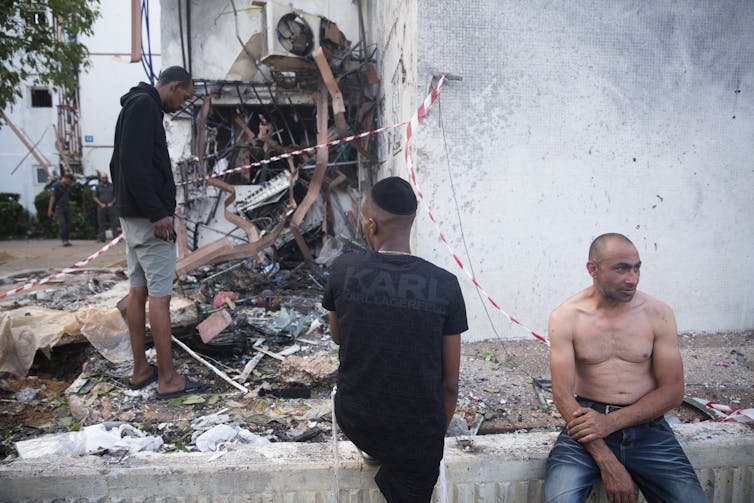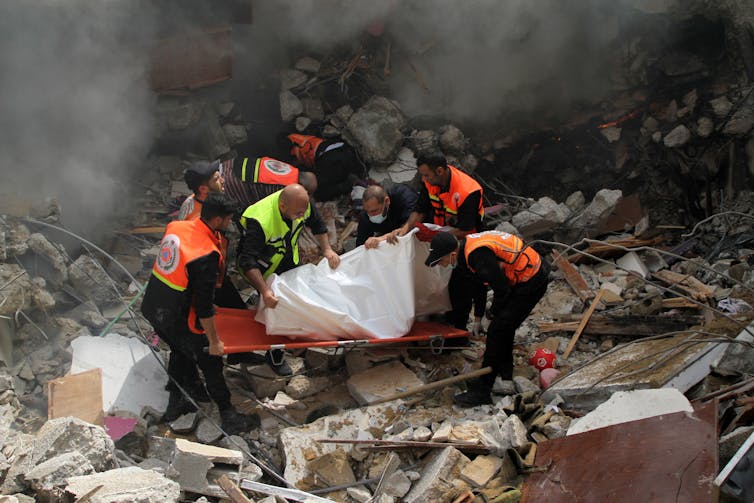Both Israel and Hamas are aiming to look strong, instead of finding a way out of their endless war
- Written by Boaz Atzili, Associate Professor of International Relations, American University School of International Service
Israel and Hamas are locked in ever-escalating rounds of violence[1].
This is not new. Every few years, large-scale violence erupts[2] for a few days or weeks and ends with a temporary ceasefire that essentially returns the situation to the same depressing status quo: The Gaza Strip besieged and devastated[3] and the adjacent Israeli population in a constant fear of the next attack as well.
Though this is far from a symmetric conflict – Israel has vastly more military resources than Hamas[4] – it is traumatic on both sides.
And neither side has a vision[5] of either actual military resolution or a diplomatic solution to the impasse.
Israeli leaders know[6] that pressing the offensive in Gaza will prolong the missile barrage on its towns and cities, including even Tel Aviv, Israel’s largest city, which in the past has not endured such ferocious rocket attacks[7]. Hamas leaders know that the price the people of Gaza pay for their continued rocket launches is disproportionately high and rising.
So why keep escalating? Because the prize for each side is to be seen as tougher than the other. And there is no end to that contest.
 Israelis look at the site of a rocket strike from the Gaza Strip on May 17, 2021 in Ashdod, Israel.
Amir Levy/Getty Images[8]
Israelis look at the site of a rocket strike from the Gaza Strip on May 17, 2021 in Ashdod, Israel.
Amir Levy/Getty Images[8]
Making the other side suffer
The Gaza Strip[9] is a tiny and densely populated strip of land by the Mediterranean Sea. Since 2007, Hamas, which Israel defines as a terrorist organization[10] but most Palestinians regard as a legitimate political party, has been the de facto ruler of the area.
Also since that year, Israel has been blockading the Gaza Strip[11] in retaliation for Palestinian rockets fired from Gaza, aimed across the border at Israel. The result has been an increasingly severe economic crisis, hunger and desperation in Gaza[12]. Repeated rounds of violence[13] did not fundamentally change this situation, and the current one is looking no different.
Israel’s main goal is to be seen as tough against its enemies, including Hamas. This isn’t done to achieve better lives for its Israeli citizens or even to advance national interests, but as a goal in and of itself, as demonstrated in a book[14] Wendy Pearlman and I authored on the subject.
Despite the asymmetry of their forces, the mode of thinking is quite similar in the leadership of Hamas. That’s evident from the repeated rounds of violence that it initiates that result in no strategic achievement, but which enhance the prestige of Hamas[15] as standing up to Israeli oppression.
And for both sides, reputation is not defined as showing resolve, resilience or perseverance. That could be accomplished by defensive means.
This boils down to a deadly calculus: The more the other side suffers, the better your reputation, no matter how much your side suffers as well.
Here’s how that works: An Israeli child is killed in a Hamas rocket attack on Sderot[16], just east of the Gaza Strip. Israeli rockets then pulverize a building in Beit Lahia a few miles away, killing four children[17] from one family in the process.
Israel flattens a residential tower in the Gaza Strip. Hamas then increases the range and quantity of missiles launched[18] toward central Israel.
And so it continues in a fatal tit-for-tat, with Israeli violence responding many times more intensely to each instance of Hamas violence.
Not rational
Scholars generally see a country’s attempts to establish a reputation for resolve as part of a rational action to deter[19] attacks by its enemy.
So, if either Israel’s leaders or those of Hamas think that their action would prevent future attacks by the enemy, this ferocity might make sense – regardless of its morality. But, as is obvious, neither sides’ actions do.
When actual victory is impossible and when the two sides are reluctant to engage in meaningful negotiation, the escalation is meant, instead, to create “a picture of victory,”[20] as Zvi Bar'el, a news analyst for Israeli newspaper Ha'aretz described it on May 12, 2021.
On May 11, Hamas leader Ismail Haniyeh declared that the organization “achieved victory in the battle of Jerusalem,” referring to the conflict over eviction of Palestinians from their homes[21] that started this round of conflagration. He said the organization has “set a new balance of power[22]” against Israel.
Yet clearly, as Gaza is crumbling under the ferocity of Israel’s bombardments and Jerusalem remains firmly controlled by Israel, Hamas made no such achievements.
Israel’s Defense Minister Benny Gantz said that the Israeli leadership’s goals were “to bring long-term peace, strengthen the moderate forces in the region and deprive Hamas of strategic capabilities[23].”
Yet Israel’s actions, like previous rounds of violence, only strengthen the political and military power of Hamas, as evidenced by its ability to target more of Israel’s territory[24] than ever before, and over a longer time period than before. Israel’s citizens, in cities from Beer-Sheva in the south to Tel Aviv, farther north, continue to face a barrage of missiles from Gaza. And as the carnage in Gaza increases, the diplomatic damage to Israel is increasing as well.
 Palestinian civil defense members rescue a man who was trapped under the rubble of a destroyed house following an Israeli airstrike in Gaza City on May 16, 2021.
Rizek Abdeljawad/Xinhua News Agency via Getty Images[25]
Palestinian civil defense members rescue a man who was trapped under the rubble of a destroyed house following an Israeli airstrike in Gaza City on May 16, 2021.
Rizek Abdeljawad/Xinhua News Agency via Getty Images[25]
Playing to their audience
What could be the purpose of the Israeli and Hamas leaders’ actions?
Their picture of victory is targeted solely at domestic audiences[26]. Both Israel and Hamas frequently use the term “deterrence” when justifying their action against each other.
But their practice is not actually a rational attempt to sway the opponent’s action. It is not a rational attempt to make their own public more secure. It does not, therefore, serve to enhance deterrence. Convincing your own public that you have been victorious does not affect the degree to which your enemy is deterred.
For Israel, such distortion of the understanding of dynamics of deterrence is not new[27]. Israel’s retaliation policy started in the 1950s as a fairly rational attempt at deterring enemies from threatening Israeli interests.
But then it became a “strategic culture,” or a habitual reaction to any attack on Israeli soil, whether that retaliation is likely to yield positive results or not.
Israeli bombing of Lebanese infrastructure[28] during the 2006 war serves as a good example. As in that war, Israel attempts today in Gaza to achieve a picture of victory rather than concrete aims. And Hamas wants to achieve the same goal.
So long as the two sides are each aiming to convince their own public of their superiority, military ingenuity and resolve, and as long as the leaders on both sides do not care about the consequences of their actions, their citizens and the rest of the world – watching in horror – should expect no progress.
[Get the best of The Conversation, every weekend. Sign up for our weekly newsletter[29].]
References
- ^ ever-escalating rounds of violence (www.nytimes.com)
- ^ large-scale violence erupts (www.theguardian.com)
- ^ The Gaza Strip besieged and devastated (www.pri.org)
- ^ Israel has vastly more military resources than Hamas (www.bbc.com)
- ^ neither side has a vision (apnews.com)
- ^ Israeli leaders know (www.i24news.tv)
- ^ which in the past has not endured such ferocious rocket attacks (www.nytimes.com)
- ^ Amir Levy/Getty Images (www.gettyimages.com)
- ^ The Gaza Strip (www.britannica.com)
- ^ Hamas, which Israel defines as a terrorist organization (www.bbc.com)
- ^ Israel has been blockading the Gaza Strip (www.ochaopt.org)
- ^ severe economic crisis, hunger and desperation in Gaza (news.un.org)
- ^ Repeated rounds of violence (blog.oup.com)
- ^ a book (cup.columbia.edu)
- ^ prestige of Hamas (www.brookings.edu)
- ^ killed in a Hamas rocket attack on Sderot (thehill.com)
- ^ killing four children (www.aljazeera.com)
- ^ missiles launched (www.reuters.com)
- ^ a rational action to deter (doi.org)
- ^ “a picture of victory,” (www.haaretz.com)
- ^ eviction of Palestinians from their homes (www.reuters.com)
- ^ power (www.israelhayom.com)
- ^ capabilities (hamodia.com)
- ^ target more of Israel’s territory (www.haaretz.com)
- ^ Rizek Abdeljawad/Xinhua News Agency via Getty Images (www.gettyimages.com)
- ^ domestic audiences (www.vox.com)
- ^ dynamics of deterrence is not new (cup.columbia.edu)
- ^ Israeli bombing of Lebanese infrastructure (www.reuters.com)
- ^ Sign up for our weekly newsletter (theconversation.com)
Authors: Boaz Atzili, Associate Professor of International Relations, American University School of International Service

